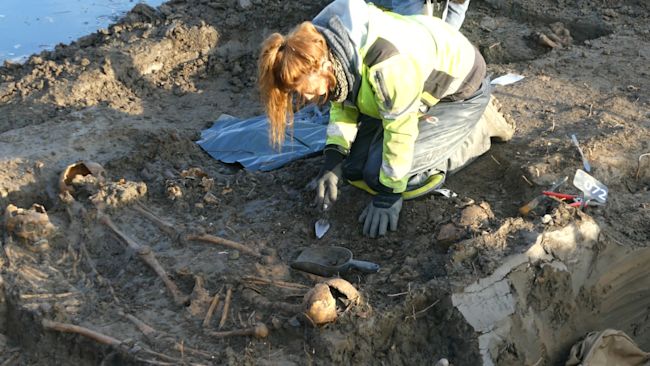A mass grave believed to contain the bodies of 81 British solders has been uncovered 200 years after their deaths.

The grave was uncovered by archaeologists excavating a site in Vianen, the Netherland and archaeologist Hans Veenstra believes there are more mass graves in the area.
Mr Veenstra said his team found the mass grave while doing some research in the area as there were plans to dig a new canal.
He said: “We were almost done, then my colleague saw a little piece of bone sticking out of the slope of the canal and we started to dig and it turns out to be a skeleton and we (went further) and found more skeletons.
“It was a very strange moment for us.”
- Lockdown sparks archaeological finds in back gardens
Experts say there are an increasing number of clues to suggest that the grave of teenage boys and men, aged 14 to 30, contains the bodies of British solders who were injured and died in the First War of the Coalition (1792-1797).
The set of wars involved several European powers fighting against the Kingdom of France and then the French Republic that succeeded it.
The war was devastating for the British.
Diaries of British solders reveal some of the hardships that were endured as a result of disease, malnutrition and harsh winter conditions.
Mr Veenstra said: “There’s a lot of things going on in your mind when you find something like this.
“First of all, there’s the excitement, because you don’t expect to find anything like this, it’s really extraordinary.
“But also, it’s human remains, so it’s very emotional because you’re dealing with guys that did not have a very peaceful life.
“They had a hard life and they died very young. It’s a sad story as well.”

Skeletons believed to belong to British soldiers Credit: Ton van Es – www.devliegendefilmer.nl
It was previously believed that traces of extreme violence were found on the human remains, but a closer look at some skeletons revealed saw marks, indicating the marks were by surgeons amputating limbs from the wounded or conducting autopsies.
Evidence of medical treatments on the bodies suggest a field hospital for injured soldiers was nearby, archaeologists said. And there was a field hospital for British solders in the ruins of the castle of Vianen – just 100 yards from the mass grave.
According to an account in the Amsterdamse Courant (Amsterdam Journal), the hospital was established on December 28, 1794 and was run by the British, who were fighting the French, alongside the State Army and troops from Prussia.
The field hospital moved to the city of Amersfoort on December 30, 1797, sources suggest.
Researchers dated the mass grave’s remains to the war due to specific wear found on some dental remains, believed to be caused by the round stems of pipes.
Pipe smoking in the Netherlands started at around 1600 in the wealthy classes, but from 1690 onwards, it became a widespread practice. And as the dig suggested the victims were relatively poor, experts concluded that the grave could not date before 1690.

An archaeologist digging up a skeleton from the mass grave Credit: Ton van Es – www.devliegendefilmer.nl
Christa Hendriksen, councillor of the municipality of Vijfheerenlanden says: “All findings make it plausible that the mass grave that was discovered recently during the preparations for a city canal, can be linked to the latter part of the 18th century and the First War of the Coalition, and that the boys and men who were buried here were actually British citizens.
“Further research (also into archives) will have to show whether these suspicions are correct.
“It is entirely coincidental that the C-14 testing, the carbon dating research, will take place in the United Kingdom. Because of the British link, we have contacted the British government to inform them of this mass grave.”
British Ambassador to the Netherlands Joanna Roper said: “‘This is an extraordinary discovery from a period of close cooperation between the UK and the Netherlands in the 18th century and is yet another example of the close and historical ties between our two countries.
“I am very pleased that the UK Ministry of Defence archaeological team is working closely with their Dutch colleagues from the Gemeente Vijfheerenlanden to help them continue their research to identify these remains, and to ensure that they are treated with the respect that they deserve.”





